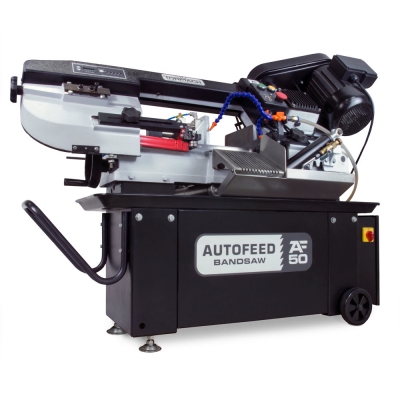
Tormach Inc. has started the preproduction beta phase of its AF50 autofeed bandsaw.
Features include:
■ Pneumatic Clamping System
■ Hydraulic Feed Control
■ Programmable Automatic Workpiece; Positioning Accommodates Cut Lengths between 0.157"-50"
• Up to 10" per stroke
• Maximum five strokes (50") per cut
• Maximum 999 strokes per program
• Stroke countdown display
■ Integrated Coolant System (2.3 gallon capacity)
■ 4 Blade Speeds
■ Blade Tensioning System
■ Portable
Specifications:
■ Capacity: 7" round at 90°; 6" x 8" flat at 90°
■ Blade speeds: 135-161-226-394 fpm
■ Blade size: 93" x 0.74" x 0.035"
■ Feed control: Hydraulic adjustment
■ Vise: Pneumatic clamping
■ Motor: 1-hp 115-VAC single phase
■ Shipping weight: 385 lbs.
Dimensions:
■ Table Height: 21.75"
■ Length: 48" + length of blade tension gauge
■ Width: 36" (includes outfeed guide)
■ Height with saw at rest: 39"
Power Requirements:
115-VAC single phase
Contact Details
Related Glossary Terms
- bandsaw
bandsaw
Machine that utilizes an endless band, normally with serrated teeth, for cutoff or contour sawing. See saw, sawing machine.
- coolant
coolant
Fluid that reduces temperature buildup at the tool/workpiece interface during machining. Normally takes the form of a liquid such as soluble or chemical mixtures (semisynthetic, synthetic) but can be pressurized air or other gas. Because of water’s ability to absorb great quantities of heat, it is widely used as a coolant and vehicle for various cutting compounds, with the water-to-compound ratio varying with the machining task. See cutting fluid; semisynthetic cutting fluid; soluble-oil cutting fluid; synthetic cutting fluid.
- feed
feed
Rate of change of position of the tool as a whole, relative to the workpiece while cutting.
- flat ( screw flat)
flat ( screw flat)
Flat surface machined into the shank of a cutting tool for enhanced holding of the tool.
- sawing machine ( saw)
sawing machine ( saw)
Machine designed to use a serrated-tooth blade to cut metal or other material. Comes in a wide variety of styles but takes one of four basic forms: hacksaw (a simple, rugged machine that uses a reciprocating motion to part metal or other material); cold or circular saw (powers a circular blade that cuts structural materials); bandsaw (runs an endless band; the two basic types are cutoff and contour band machines, which cut intricate contours and shapes); and abrasive cutoff saw (similar in appearance to the cold saw, but uses an abrasive disc that rotates at high speeds rather than a blade with serrated teeth).








